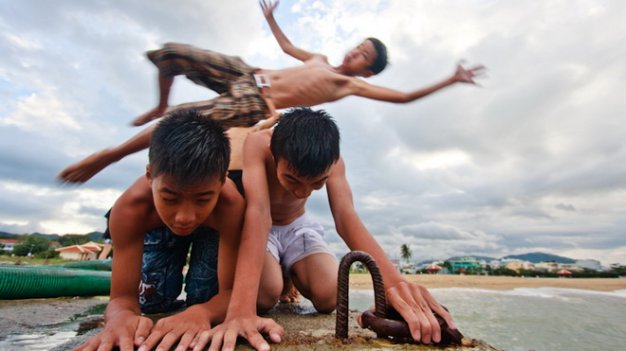Parkour has gained an increasingly stronger foothold among young Vietnamese, especially those in Hanoi and Ho Chi Minh City, who want to turn it into a street art in lieu of a risky sport.
A blend of sports, art, kung fu and performance, parkour can be understood as moving over, under, around, and through obstacles elegantly, and with efficiency.
A form of free running, parkour is a holistic training discipline using flexible movement that developed from military obstacle course training.
Practitioners aim to get from one place to another in the most efficient way possible by using their body and the surroundings for propulsion, with a focus on maintaining as much momentum as possible while still remaining safe.

Parkouring in Nha Trang City, the capital of the south-central province of Khanh Hoa. Photo: Tuoi Tre
Developed in France, primarily by Raymond Belle, David Belle, and Sébastien Foucan during the late 1980s, parkour gained popularity in the late 1990s and 2000s through films, documentaries, and advertisements featuring these practitioners and others.
In its infancy in Vietnam
Vietnamese youth first learned about parkour around 2006 through clips on the Internet.
The sport has quickly gained in appeal thanks to its simplicity and novelty.
A number of parkour clubs can also be found in many Vietnamese cities, though Hanoi and Ho Chi Minh City boast the most activity.

A traceur trains in Nha Trang City. Photo: Tuoi Tre
Hanoi is currently home to five or six parkour clubs, which have drawn a few hundred practitioners, according to Vietnamplus, an affiliate of the Vietnam News Agency.
The most famous current club in Hanoi is Joker, with a membership of around 50.
Mario is also another widely known club in the capital.
Pham Viet Trung, who has recently returned from his studies in Poland, is one of Joker’s leaders and the country’s pioneering parkour practitioners.
“Asians and Vietnamese people in particular are cut out for the sport. Vietnamese parkour players have earned a certain reputation among their counterparts in other countries and parkour powers, such as France and the U.K.,” he added.
The sport places more demand on flexibility, agility and creativity rather than physique, Trung explained.
Players can come from a wide age bracket, as long as they have a good pair of shoes and a comfy outfit.
Parkour players, mostly young males, are now easily spotted on the street performing maneuvers including speed vaults, obstacle running, climbing, swinging, vaulting, jumping, rolling, and quadrupedal movements.

Parkouring in the sea. Photo: Tuoi Tre
Players can practice the sport alone or with others. Although it can be practiced in any location, it is generally practiced in urban spaces.
Groups of parkour practitioners generally frequent Thong Nhat Park and the campus of the University of Science and Technology in Hanoi for practice sessions, while their counterparts in Ho Chi Minh City usually gather at Le Thi Rieng Park in District 10.
However, many young traceurs, as parkour practitioners are called, say that their families frown upon their hobby, which they consider too dangerous and reckless.
In reality, one of the sport’s utmost requirements is ensuring players’ safety, as it was originally designed to help soldiers steer clear from danger, they explained, though admitting minor injuries are commonplace.
“Parkour helps me overcome my fears, shyness and indecisiveness and stay fit and slim at the same time. Our hope is that our families will be supportive of our pursuit and the sport will become widely popular,” Viet Trung said.

A young man performs a parkour movement on the street in Hanoi. Photo: Vietnamplus.
According to Phuong, a long-time traceur, the local parkour community has tended to develop the sport into street art rather than a risky sport.
“Parkour needs greater investment, better organization and coaching and more solid theoretical background if it is to grow in the coming time,” the Joker leader Trung said, adding that most traceurs now teach themselves the maneuvers from clips on the Internet or word of mouth, which notably hampers training efficiency and performance.
Like us on Facebook or follow us on Twitter to get the latest news about Vietnam!



















































